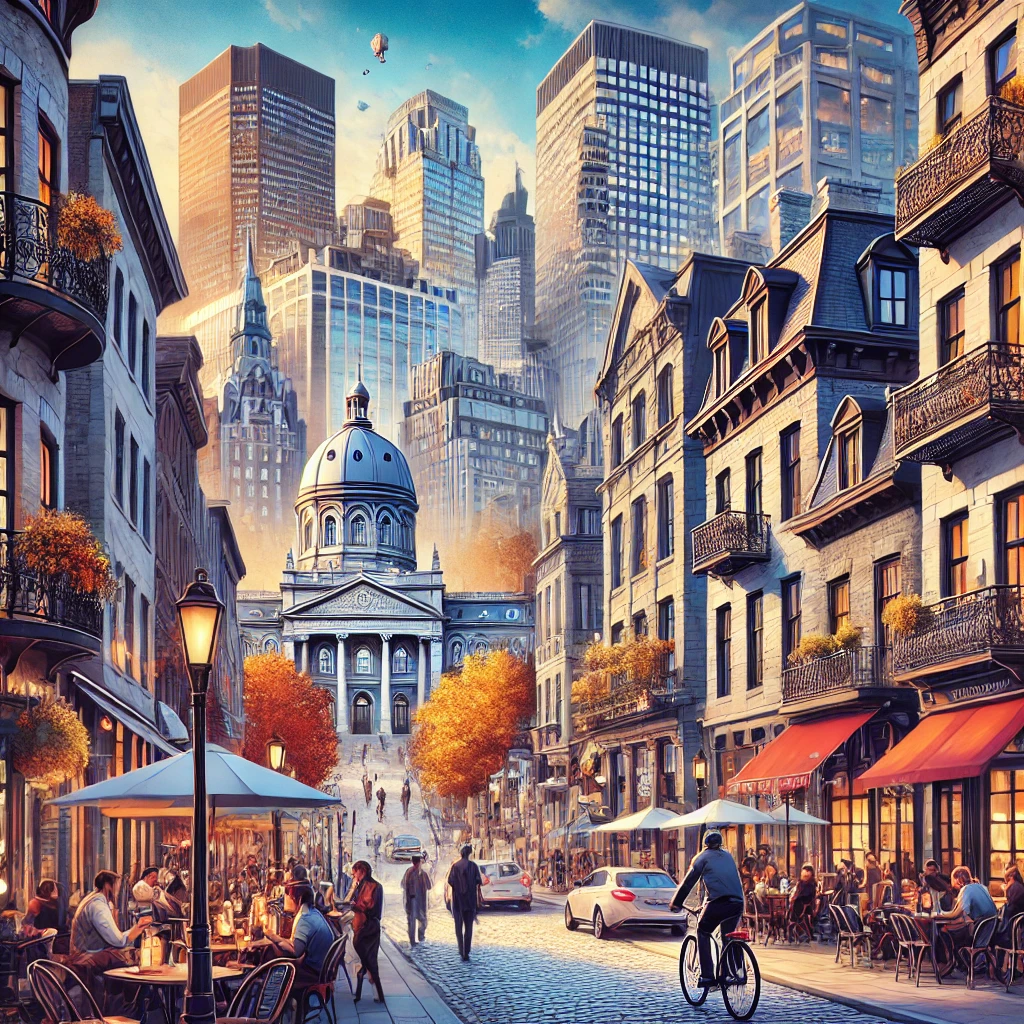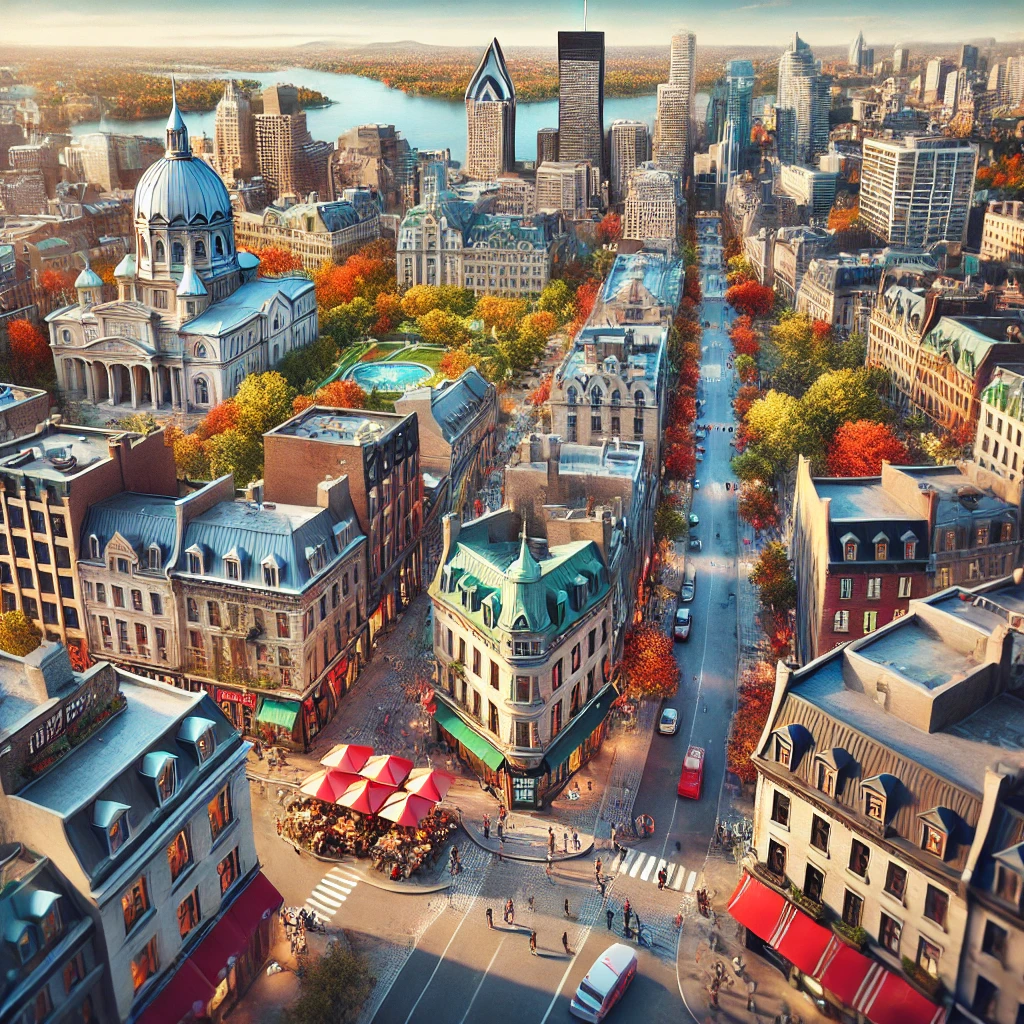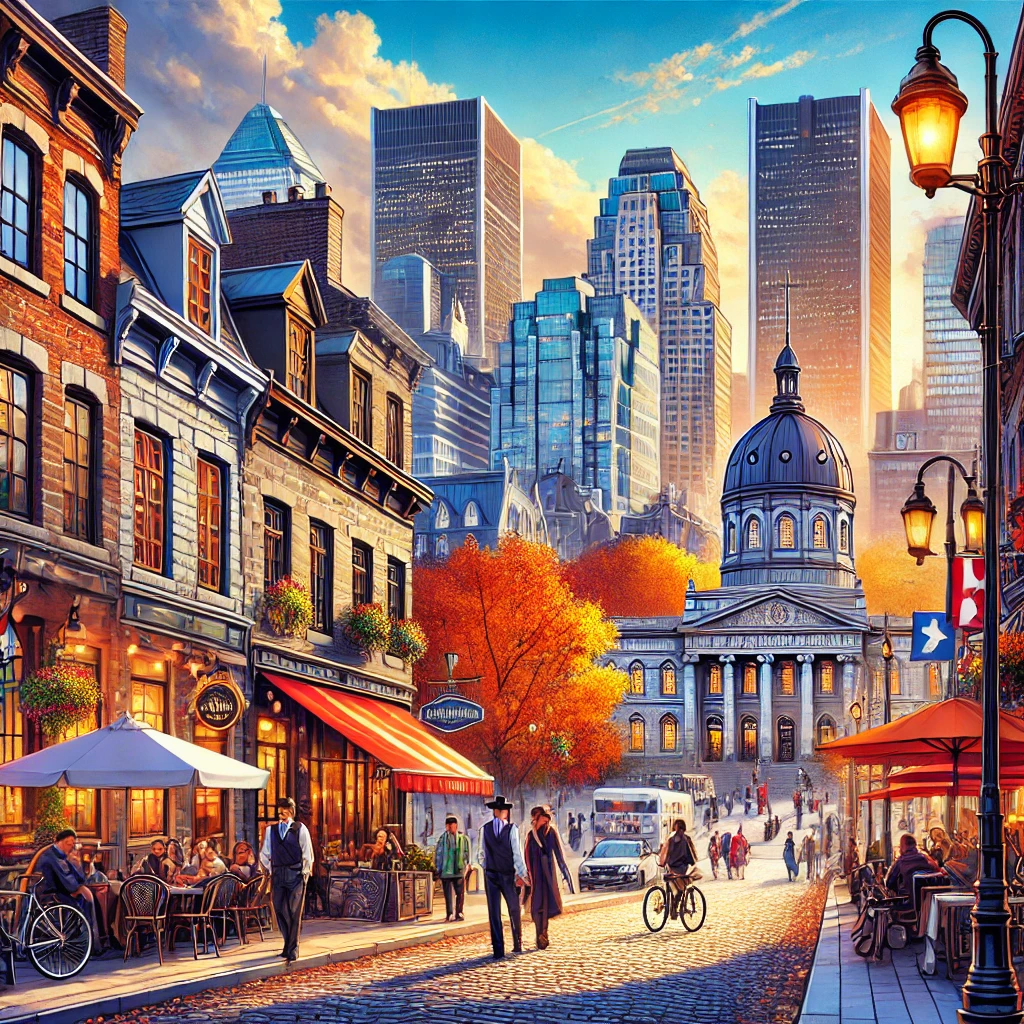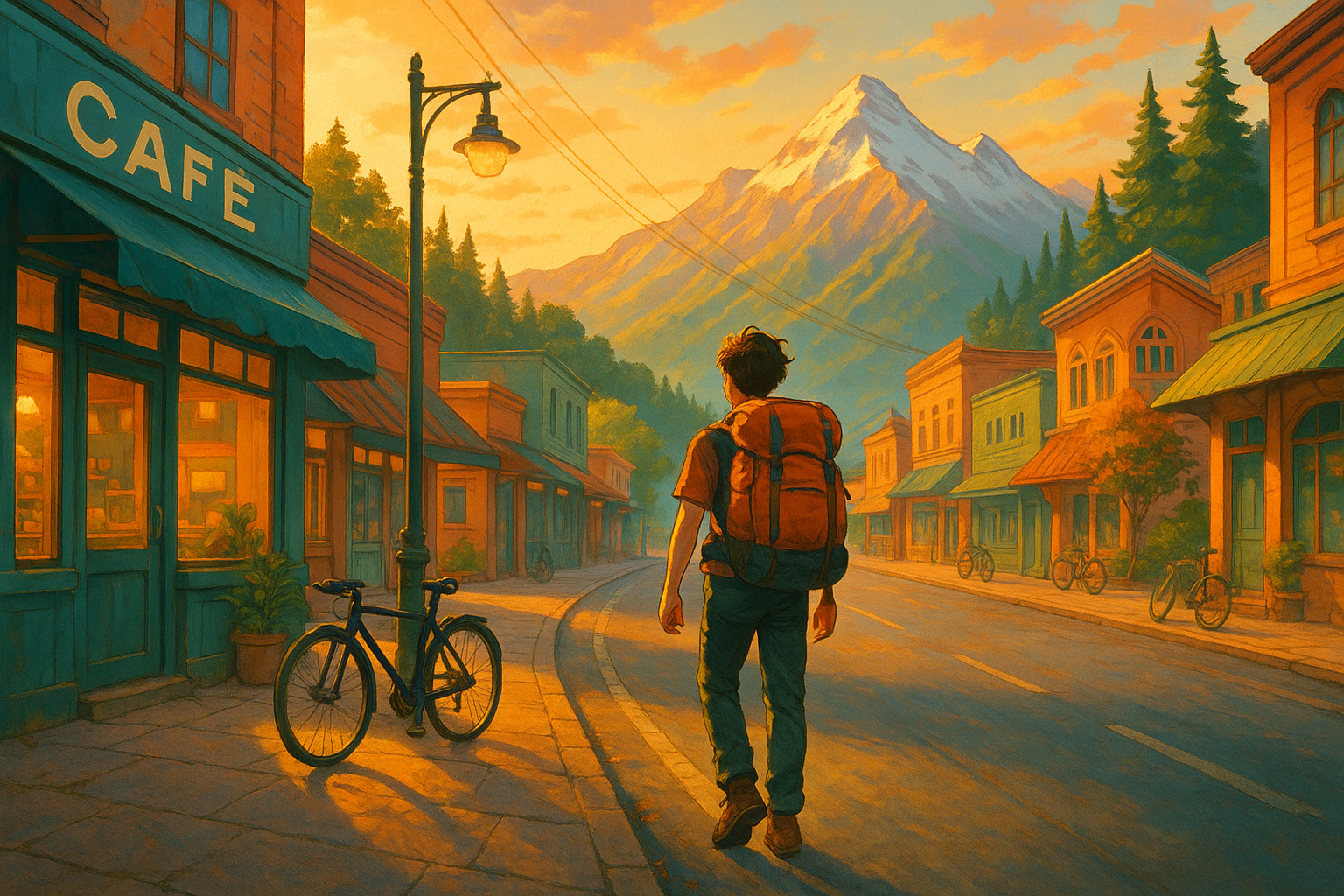Table of Contents
Introduction to Montreal
Montreal, the largest city in the province of Quebec, stands as a vibrant testament to Canada’s cultural diversity and historical richness. This city is not only the second-largest French-speaking city in the world, following Paris, but it also boasts a unique blend of French Canadian heritage and contemporary urban life. Established in 1642, Montreal has evolved through centuries of architectural, culinary, and artistic influences, making it a captivating cultural hub that attracts millions of visitors each year.

As one traverses the winding streets of Old Montreal, the well-preserved 17th-century buildings invoke a sense of nostalgia, presenting an enchanting glimpse into the city’s rich past. Cobblestone pathways lead to historical landmarks such as the Notre-Dame Basilica and the Montreal City Hall, where centuries of tradition and community come alive. This old-world charm is complemented by the modern fabric of the city, characterized by vibrant art scenes, discerning gastronomy, and dynamic nightlife, creating an alluring juxtaposition for residents and tourists alike.
Montreal’s significance extends beyond its architectural beauty; it is often regarded as a center for culture, education, and commerce. The city hosts numerous festivals, including the renowned Montreal International Jazz Festival and Just For Laughs, which showcase its artistic vibrancy and attract global participants. The cultural tapestry is further enriched by the city’s diverse population, where communities from around the world contribute to a myriad of cultural expressions, culinary experiences, and social interactions.
Thus, Montreal presents a compelling narrative that intertwines its historical essence with a forward-thinking outlook. As we journey through its myriad attractions, the distinctive blend of old-world charm and modern vibes will become increasingly evident, forging an unforgettable experience that exemplifies the best of Canadian culture.
Historical Landmarks: A Walk Through Time
Montreal, a city rich with history and culture, offers a plethora of historical landmarks that invite both residents and visitors to embark on a journey through time. Old Montreal stands out as a captivating district, reminiscent of the city’s early days. With cobblestone streets and stunning architecture, this area showcases the evolution of the city from its founding in 1642. Walking through Old Montreal, one encounters charming buildings that date back over a century, each telling a story of yesteryears, from merchant houses to public squares.
One of the most striking sites within Old Montreal is the Notre-Dame Basilica. This architectural masterpiece, completed in 1829, is celebrated not only for its grandeur but also for its intricate Gothic Revival design. The basilica’s interior, adorned with stunning stained glass windows and detailed wooden carvings, transports visitors into a serene atmosphere. The historical significance of Notre-Dame Basilica is immense, serving as a focal point for major public events and celebrations throughout its storied past.
Another notable landmark is the Bonsecours Market, which has stood as a significant hub since the early 19th century. Originally a marketplace for local merchants, it has transformed over the years into a vibrant space for artisanal vendors, showcasing Quebec’s diverse heritage through craft and cuisine. The market, with its iconic domed structure, reflects the architectural evolution of Montreal, embodying a blend of neoclassical and contemporary styles as it adapts to modern-day needs while honoring its historical roots.
These sites, among others, highlight Montreal’s capacity to preserve its historical integrity while embracing modernization. The rich history encapsulated in the architectural styles of Old Montreal, Notre-Dame Basilica, and Bonsecours Market offers a testament to the city’s journey through time, serving as a bridge between its glorious past and dynamic present.
Vibrant Neighborhoods: The Heart of the City
Montreal is a city defined by its distinct neighborhoods, each offering a unique cultural tapestry that is irresistible to both residents and visitors. One of the standout areas is Le Plateau-Mont-Royal, celebrated for its bohemian atmosphere. This neighborhood is dotted with colorful murals and cozy cafés, creating an artistic vibe that attracts creatives and intellectuals alike. The streets are filled with vibrant boutiques, theaters, and parks, embodying a spirit of community and artistic expression that is palpable throughout the area.
Mile End, known for its eclectic character, is another gem in Montreal’s array of neighborhoods. It boasts a diverse range of eateries, from traditional Jewish delis to trendy vegan cafes. The area is also home to a community of artists and musicians, and you can often find live performances and open-mic nights that showcase local talent. The charming streets invite exploration, with many hidden gems waiting to be discovered, such as artisanal shops and vintage clothing stores, reflecting the neighborhood’s unique identity.
Little Italy offers a delightful contrast, showcasing Montreal’s rich Italian heritage. The heart of this neighborhood is the iconic Church of the Madonna della Difesa, which stands as a testament to the community’s deep-rooted traditions. Little Italy is also known for its bustling mercado, where vendors sell fresh produce, cheeses, and meats, adding to the neighborhood’s vibrant street life. The annual celebrations, including the festival of Saint Anthony, bring together residents and visitors, highlighting the neighborhood’s strong sense of community and tradition.
As you wander through these diverse neighborhoods, the dynamic spirit of Montreal truly comes to life. Each area contributes its own flavor to the city’s overall charm, making Montreal a captivating destination for exploration and cultural immersion.
Culinary Delights in Montreal
Montreal boasts a vibrant gastronomic scene that captivates food enthusiasts from around the globe. The city is renowned for its unique culinary landscape, which seamlessly marries traditional flavors with modern techniques and influences. Among the iconic dishes that define Montreal’s palate, poutine stands out as a must-try comfort food. This indulgent dish features crispy fries smothered in rich gravy and topped with cheese curds, offering a savory experience that locals and tourists alike cannot resist.
In addition to poutine, Montreal is celebrated for its bagels, which differ from their New York counterparts. These delightful treats are handcrafted, boiled in honey-sweetened water, and baked in wood-fired ovens, resulting in a chewy texture and a slightly sweet flavor. St-Viateur Bagel and Fairmount Bagel are two legendary establishments where visitors can sample fresh, warm bagels straight from the oven.
Another culinary highlight is the famous Montreal-style smoked meat sandwich. Typically made from brisket that has been cured and seasoned, it is often served stacked high on rye bread with mustard. Schwartz’s Deli is a historic venue that has been serving this iconic dish since 1928, becoming a pilgrimage site for many food lovers.
Montreal’s food scene extends beyond its iconic dishes. The city hosts numerous food markets, such as the Jean-Talon Market, where vendors offer fresh produce, artisanal cheese, and local delicacies. Additionally, culinary festivals like “MTL à Table” showcase the city’s diverse restaurant landscape, allowing chefs to present their creativity and innovation while indulging visitors in exclusive tasting menus. With its fusion of old-world charm and modern culinary practices, Montreal serves as a thriving destination for foodies seeking memorable gastronomic experiences.
Art and Culture: The Creative Pulse of Montreal
Montreal is renowned for its vibrant arts scene, which reflects a harmonious blend of historical influences and contemporary expression. The city is home to numerous museums and galleries that showcase a diverse array of artistic styles and mediums. Notable institutions such as the Montreal Museum of Fine Arts and the Museum of Contemporary Art present both local and international works that span centuries. These venues are instrumental in fostering a cultural dialogue that highlights Montreal’s unique artistic identity.
In addition to its established institutions, the city’s streets have become a canvas for creativity. Street art flourishes throughout various neighborhoods, transforming urban spaces into open-air galleries. Artists such as murals and graffiti creators contribute to a rich tapestry of color and storytelling that captures the essence of the city’s dynamic spirit. These vivid displays not only enhance the aesthetic appeal of Montreal but also offer insights into the social and cultural narratives of its communities.
Montreal’s commitment to arts and culture is further demonstrated by its hosting of major festivals that attract visitors from around the globe. The Montreal International Jazz Festival, one of the largest in the world, showcases an impressive lineup of musicians and performers, creating an electrifying atmosphere that resonates throughout the city’s streets. Similarly, the Just for Laughs Comedy Festival has earned a reputation for featuring renowned comedians and emerging talent alike, solidifying Montreal’s status as a hub for creative expression in humorous arts.
These cultural events underscore the city’s dedication to celebrating creativity, fostering artistic endeavors, and promoting multicultural dialogue. Montreal not only values its artistic heritage but also actively contributes to the evolution of contemporary art, making it an essential destination for those who appreciate the creative pulse of a thriving metropolis.
Parks and Outdoor Spaces: Nature in the City
Montreal, a vibrant metropolis, is renowned for its beautiful parks and outdoor spaces that offer residents and tourists alike a refreshing escape from urban life. As one of the key elements contributing to the city’s unique atmosphere, parks play an essential role in enhancing the quality of life in this bustling environment. Prominent green spaces such as Mount Royal Park and the Lachine Canal not only provide recreational opportunities but also foster a connection with nature.
Mount Royal Park, designed by the famous landscape architect Frederick Law Olmsted, is a prime example of how natural beauty can be integrated into an urban setting. The park features a multitude of walking and biking trails, picnic areas, and picturesque viewpoints that allow visitors to admire the sweeping vistas of the city below. In every season, the park showcases its beauty, from the vibrant foliage in autumn to the snow-covered landscape in winter, making it a year-round destination for outdoor enthusiasts.
The Lachine Canal, stretching several kilometers through the heart of Montreal, serves as another essential outdoor space. It is surrounded by scenic pathways that are perfect for cycling, jogging, or leisurely strolls. Along the canal, one can find various parks and waterfront areas equipped for recreational activities, such as kayaking, paddleboarding, and fishing. These opportunities bring a sense of tranquility amid the urban sprawl, encouraging both relaxation and physical activity.
Green spaces are vital in promoting biodiversity and improving urban air quality, which enhances the overall living experience. The abundance of parks and outdoor activities in Montreal not only contributes to the physical well-being of its residents but also fosters community bonds and interactions. These spaces serve as gathering points, where people can come together to enjoy organized events or simply the beauty of nature. The dynamic interplay between outdoor spaces and city life leads to a culture that celebrates both relaxation and engagement within Montreal.
Nightlife and Entertainment: After Hours in Montreal
Montreal’s nightlife is a multifaceted experience that caters to a wide array of tastes, ensuring that both locals and visitors can find something to enjoy after the sun sets. The city’s vibrant entertainment landscape is not just limited to bars and nightclubs; it encompasses an eclectic mix of venues, events, and performances that create an unforgettable atmosphere.
One of the most iconic aspects of Montreal’s nightlife is its extensive range of bars, which vary from cozy speakeasies to lively rooftop lounges. For those seeking an intimate evening, the myriad of cocktail bars scattered across the Plateau-Mont-Royal area offer expertly crafted drinks within a stylish ambiance. Conversely, for those who crave a more energetic setting, the downtown area is home to numerous nightclubs where both local and international DJs spin tracks that keep the dance floors pulsing until the early hours of the morning.
In addition to bars and clubs, Montreal prides itself on its vibrant live music scene. The city hosts an array of music venues that feature local talent as well as renowned artists, ensuring that there is always something to see. From cozy jazz clubs in the historic district of Old Montreal to larger concert halls that host big-name acts, the musical diversity is profound. Various neighborhoods also regularly feature open-mic nights, showcasing emerging artists and giving patrons a glimpse of the city’s burgeoning talent.
Theater enthusiasts will also find plenty to indulge in, with numerous performance spaces showcasing everything from contemporary performances to classical productions. The Quartier des Spectacles, a major cultural hub, frequently hosts events, festivals, and exhibitions, offering a rich tapestry of entertainment options available year-round.
Ultimately, whether one is in the mood for a quiet drink, an exhilarating dance session, or a captivating live performance, Montreal’s nightlife scene presents an array of choices that reflect the city’s distinctive cultural blend. The captivating energy of the evening beckons, inviting all to immerse themselves in the dynamic after-hours offerings that Montreal has to offer.
Festivals and Events: Celebrating Montreal
Montreal is renowned for its vibrant festivals and events, which significantly contribute to the city’s dynamic atmosphere and cultural identity. Each year, thousands flock to this urban tapestry, where celebrations of all kinds highlight the rich history and contemporary evolution of the area. From music and film to food and cultural gatherings, these events offer something for everyone, creating a unique blend of old-world charm and modern vibrancy.
One of the most celebrated events is the Montreal International Jazz Festival, which draws in jazz enthusiasts from around the globe. This festival showcases both local talents and world-renowned artists, filling the streets with the rhythmic sounds of jazz and fostering a deep appreciation for the genre. Similarly, the Just for Laughs festival offers a comedic relief, presenting renowned comedians alongside emerging talents, proving that humor can unite diverse communities.
The Festival Mondial de la Biere, or World Beer Festival, showcases Montreal’s rich brewing culture, featuring local breweries and international beers, allowing attendees to immerse themselves in the city’s culinary landscape. Food and drink enthusiasts can explore various offerings while connecting with the community. Additionally, cultural events like the Festival du Nouveau Cinema highlight the work of innovative filmmakers, enhancing Montreal’s reputation as a hub for creativity and artistic expression.
Montreal also hosts seasonal events such as the Christmas Market in the Old Port, where traditional holiday music and local crafts create a festive atmosphere, inviting residents and visitors alike to share in the joy of the season. Sports events, notably during the Formula 1 Grand Prix, transform the city into a high-octane celebration of speed, drawing international attention and boosting local tourism.
Overall, these annual festivals and events not only provide entertainment but also strengthen community ties, showcasing the diverse tapestry of talent and tradition that defines Montreal. The city’s commitment to celebrating its heritage while embracing modernity is palpable in every gathering, leaving a lasting impression on all who participate.
Conclusion: Embracing the Duality of Montreal
Montreal stands as a remarkable testament to the harmonious coexistence of historic charm and modern vitality. Throughout the exploration of this vibrant city, it has become evident that the rich tapestry of its past enhances the breath of fresh air offered by its contemporary developments. The cobblestone streets of Old Montreal, with their charming shops, cafés, and historical landmarks, invite visitors to step back in time, providing an immersive experience into the city’s early days and French heritage. This area represents not just a destination, but an invitation to connect with the stories and legacies that have shaped Montreal’s identity.

In a beautiful juxtaposition, neighborhoods such as the Quartier des Spectacles and the Plateau-Mont-Royal showcase the essence of modern Montreal, where art, innovation, and cultural dynamism flourish. The lively art festivals, cutting-edge galleries, and eclectic cafés serve as a counterpoint to the quieter historic districts, reflecting the city’s ability to adapt and evolve. This unique blend ensures that Montreal remains a stimulating place for residents and visitors alike, accommodating both lovers of antiquity and champions of modernity.
In summary, Montreal offers an unparalleled experience that captures the essence of both its storied past and its progressive future. For those seeking a destination that intertwines history and innovation, Montreal presents numerous opportunities to explore and create cherished memories. A visit to this captivating city guarantees an enriching experience that appeals to a diverse audience, fostering a deeper appreciation of its dual character. Whether wandering through the picturesque streets or engaging with contemporary culture, the enchantment of Montreal awaits exploration.





